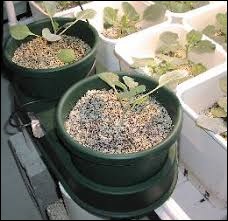Hydroponic Wick System

Each DIY wick system can be customized for the grower's priorities and current stage of production. In the above image, seedlings are growing out in a wick system. Note that a wick system still needs basics such as pots and growing media. Image courtesy of Backyard Garden Lover.
You are on Page 1 of our six page series on hydroponic wick system section. Click on any of the below pages to jump to that page.
Page 1 Page 2 Page 3 Page 4 Page 5 Page 6
Can Crops Be Germinated In This System?
The short answer is, yes. For those plants which lend themselves to being transplanted, they can be started in a wick system and then transplanted elsewhere once they have reached a suitable size. That being said, a grower who wants to use a wick system in this manner, will have to choose growing media even more carefully. Many germination setups assume that individual plants can be started in small pots which are immersed in whatever growing media the grower is using. With the wick system, that approach may not work very well because the pot would block capillary action from the surrounding growing media. One way around that would be to include a miniature wick within each little pot. That could be simple, or tedious, depending on the scale. Another option would be to use an extremely fine-grained growing media, such as sand or perlite/vermiculite, and let the plant seeds germinate directly in that media. Then when the plants reach transplant size, carefully work them out of the growing media and into whatever next container or growing media will allow them to continue their growth. While this may sound tedious as well, it’s actually a very old conventional transplant method known as pricking out the transplants. It can be done successfully and quickly, as long as the plants are handled carefully. In either case, the growing media must be very carefully chosen, and more wick used per container to ensure an evenly moist germination environment.
Can Crops Be Transplanted Into This System?
The short answer is again yes, with caveats similar to the previous section. If growers want to transplant into a wick system, they’ll have to arrange things in advance. To start with, the plants should ideally be started in the same growing media they’ll have after transplanting. This will dramatically improve transplant success rates, because the root system will already be accustomed to that particular growing media. The ideal setup would have the plants sprouted directly in a fine growing media such as sand or vermiculite/perlite, pricked out at a suitable size, and then quickly transplanted into the same media in a larger container with similar irrigation, in this context a wick system. Just as we saw for germination, any container receiving transplants should have several wicks to ensure adequate irrigation.
The period of one to two weeks after transplanting are the most precarious for plants, and a wick system can pose another layer of challenge with the slow irrigation times. A few additional precautions would be to have the receiving wick system up and running, and set up as closely to the germination system as possible, so that the growing plants experience as little change as possible.
Helpful Hints
Wick systems are popular in school classrooms, hobbyist setups, and off-grid setups because of the simplicity, low cost, and ease of maintenance. However, these systems do have a few weaknesses and special points to keep in mind, which we’ve already discussed. Ironically, the passive nature of the system requires that we exert more effort on active monitoring and maintenance for peak performance.
Given that, the biggest single helpful hint would be to watch the system closely: every element of it. Make sure that the wick is always in contact with the reservoir, that the container’s growing media is uniformly moist, that the plants are growing healthy new growth, that they aren’t showing nutrient deficiency, and that the nutrient solution in the reservoir is kept at optimum concentrations. If the system isn’t using a recirculation and/or aeration pump, stir the tank manually at least twice a day, and use any one of a variety of testing methods to check for dissolved oxygen. If pumps are used, make sure to check them several times a day for proper use, and have replacement pumps and/or parts available.
More Information
Growers interested in wick systems can read more about their use in classrooms and other learning environments at these websites:
This PDF from the Peoria, AZ K-12 school district provides a number of classroom-scale hydroponic wick systems, complete with materials lists and step by step build instructions. It also provides nutrient information, sample student questions and other classroom guides.
http://brackensteamacademy.weebly.com/uploads/7/9/8/7/79877968/h2o_grow.pdf
This PDF is the outcome from 2014 Leadership Las Vegas multi-grade hydroponics experiment, featuring elementary and advanced hydroponic projects. The 1st and 2nd grade projects featured a seed sprouting project, which then provided plants for a unique student-built system featuring a vertical tower wicking system. The PDF also details an advanced project using microcontroller integration with a growing system to monitor various growing variables in real time. The PDF covers the construction, implementation, testing and results for each phase of the multi-tier project. It includes ideas for fundraising, partnering with various local businesses, individual research projects within the larger program, and student results.
You are on Page 1 of our six page series on hydroponic wick system section. Click on any of the below pages to jump to that page.
Page 1 Page 2 Page 3 Page 4 Page 5 Page 6